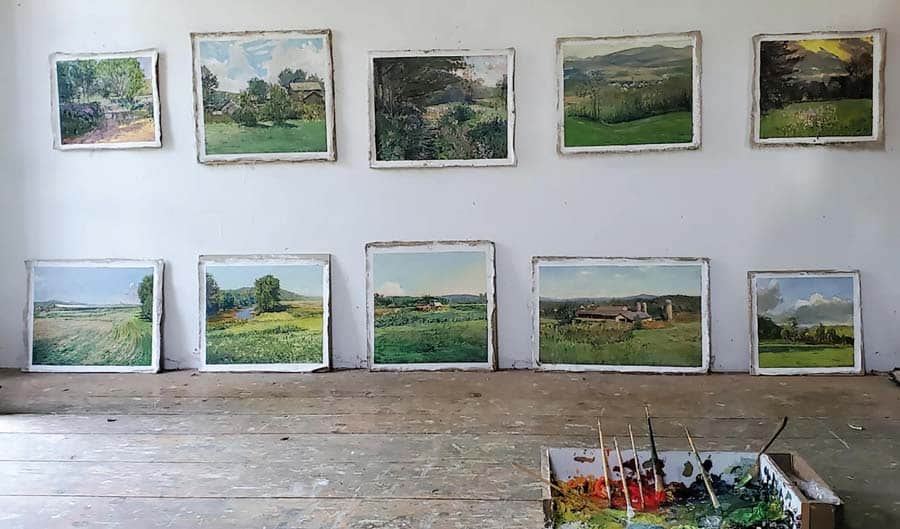
 Upon meeting Harry Orlyk, it doesn’t take but a minute to realize that you’re in the company of a very special man. He is warm and engaging. And there’s no pretense or attempt to impress. He’s just Harry. But his simple, gentle nature belies a strident com mitment to his craft and the land he loves. Not only an accomplished painter, Harry is nature’s historian.
Upon meeting Harry Orlyk, it doesn’t take but a minute to realize that you’re in the company of a very special man. He is warm and engaging. And there’s no pretense or attempt to impress. He’s just Harry. But his simple, gentle nature belies a strident com mitment to his craft and the land he loves. Not only an accomplished painter, Harry is nature’s historian.
“My upbringing planted me very solidly in a spiritual orientation to life and out of that spirituality I learned to consider the land as the most significant focus that I should keep in my lifetime.”
Born in 1947, Harry was raised with the love and security of a large extended family that began when his brave grandmother, Sophie, emigrated from Ukraine and set down roots in Cohoes, New York at the tender age of 16.
She soon married his grandfather who opened a meatpacking business that eventually employed many family members including his uncles who built their homes in the same area after returning at the end of WWII. For Harry, it was like growing up in a special village surrounded by loving aunts, uncles, and cousins. There was always someone to play with or visit.
Ukrainians are very religious people deeply rooted in Catholicism, so Harry and his cousins attended the local Ukrainian Catholic school and church. Sadly, his parents divorced when he was a small child. And though divorce is always traumatic for children, it was exceptionally hard on a child in the 50s because of the unfortunate stigma and lack of emotional support. In the Catholic religion, it was even more difficult and unforgiving so school was definitely a challenge for him.



Thankfully, the love of his village softened the edges of those early years.
As a student, Harry struggled with traditional classes. He speculates that he had severe learning disabilities that were unrecognized in those days, so he felt somewhat ostracized as a result. In fact, it was so bad that he flunked a grade and was held back in another even before making it to high school. But through it all, it was his passion for art and his obvious artistic abilities that sustained him. According to Harry, his colorings and line drawings were the only things he was ever praised for.
The earliest examples of his artwork were his coloring books. He had stacks of them and wasn’t afraid to color a giraffe blue if so inclined. Later Harry drew and colored his own images at the encouragement of his family, especially his grandmother, Sophie, who recognized his artistic talent early on. Besides coloring books, it was Sophie who would supply him with buttons and other odds and ends that he happily crafted into little masterpieces.
By the time he was in his early teens, Harry’s mother remarried, and it was his stepfather, William Shahen who stepped in and helped him pursue his art education. Shahen was a teacher in the local public school system and recognized that Harry needed more support than the Catholic schools could provide. He transferred and quickly became known as the “art guy,” taking every art class available and many independent study opportunities that were designed just for him as well.
After graduating with an impressive high school art portfolio, Harry attended the State University of New York at New Paltz. There he earned a BS degree in fine art and met his lifelong partner and wife Donna, whom he married in 1970.
In 1971, Harry enrolled in the fine art graduate program at the University of Nebraska at Lincoln. But it wasn’t until he attended the Native American Sun Dance Festival in South Dakota three years later that his true calling came to be and his artistic vision changed forever. He had been a figurative painter all his life and never thought of the landscape until he witnessed Sun Dance.
“Their ceremony showing respect for all non-human life, this awareness, really influenced me. I felt that these people know something that my culture doesn’t fully understand. That it’s about the land. Without the land we don’t have a place to stand, to sit, to find our food, to build our homes or farms.”
He soon became a student of nature and began painting landscapes in earnest. A few years after graduating with an MFA in 1974, Harry and Donna returned to New York State where the land became central to Harry’s work and his reason for breathing. And nearly 50 years later, his commitment and passion for the land continue.

But before he could support himself as an artist, he worked as an art therapist at a psychiatric hospital in Albany which gave him a steady income. His commute was long but he would stop along the way and paint landscapes, and amazingly, as funding for his job was coming to an end, someone asked to see his landscapes and bought $8000.00 worth of his paintings on the spot which launched Harry’s solo painting career. He and Donna bought a small house with land and outbuildings in Salem, New York where they raised four children and continue to reside today.
From a technical point of view, his landscapes have simple beginnings. Rather than stretch his canvases on a frame, he carefully attaches them to a piece of Homasote then prepares them with gesso. And every morning Harry loads up his paints, brushes, and a prepared canvas into his van then drives along looking for the next perfect spot to set up for a day’s work.
It should come as no surprise that he has a no-frills approach to painting. His steering wheel serves as his easel while his tubes of paint and palette sit alongside him. If it’s raining or snowing, no problem. Harry lays a piece of plywood on top of his van that extends over the windshield affording him a clear view of nature at work. When it’s cold, he bundles up. When it’s hot, he opens the windows. Simple.

His finished paintings are not large, typically in the range of 12” x 24,” because Harry feels he has the ability to best capture everything in a day’s time on a smaller scale. He uses paint directly from the tube and mixes colors on the palette which sits alongside him. He then masterfully records the textures, shapes, and light he sees with each stroke of the brush and scrape of the palette knife.



“Each day has its own face, and that’s the face I want to capture.”
Too many, it would appear as lonely, solitary work, but for Harry, it is his passion. He likens his rituals and devotion to painting the landscape to a man who be comes a priest. It’s a calling that compels him to paint as it is for a priest to serve a congregation. When darkness descends, he packs up and heads back to his studio where he may finish a few last details of the painting, then numbers it as he has been doing all of his life. After almost 50 years of painting landscapes, he’s up to 6432 paintings as of this writing!
But these days, Harry has something else up his artistic sleeve. On a 15-foot wall in Salem Art Works (SAW) gallery in Salem, New York there’s a sizable installation currently on exhibit. It is an assemblage of cardboard boxes he once used to scrape off the paint from his brushes after painting a landscape. The boxes’ connection to the land and accidental beauty gave him pause one day and inspired him to create this unique installation.
For decades Harry’s work has hung in many galleries. His first exhibit was in 1976, and since then he has had over 85 solo exhibitions and participated in more than 50 group exhibitions from California to Connecticut. Most recently, an incredible solo exhibit of over 160 of his landscapes at the Laffer Gallery in Schuylerville, New York.
When all is said and done, it is quite extraordinary that an artist will so reverently document all the nuances of the land in a single sitting and never tire of painting the shapes, light, textures, and emotions before him over and over again for decades. It’s a devotion so few will ever know or understand and a gift for those fortunate to view and perhaps own his work.
“What I have been doing primarily is doing portraits of days. I look at a day that I go out and take that period of time that I’m working, and it’s almost a composite. It’s a composite of feelings that I get, sensations of light and form but it’s also drilling for meaning out of that experience of being there at that moment for those few hours that I’m there. That’s the portrait I’m making. It’s not just a portrait of the place. And I just feel like I’ve never heard any other painter speak about the landscape in that way. I like thinking of myself as being the portraitist of days.”
Harry Orlyk is a prolific painter for sure, but he dismisses the idea that he is somehow unique. He is simply Harry, a painter of the land.
https://www.518profiles.com/portfolio-items/april-2023-issue/